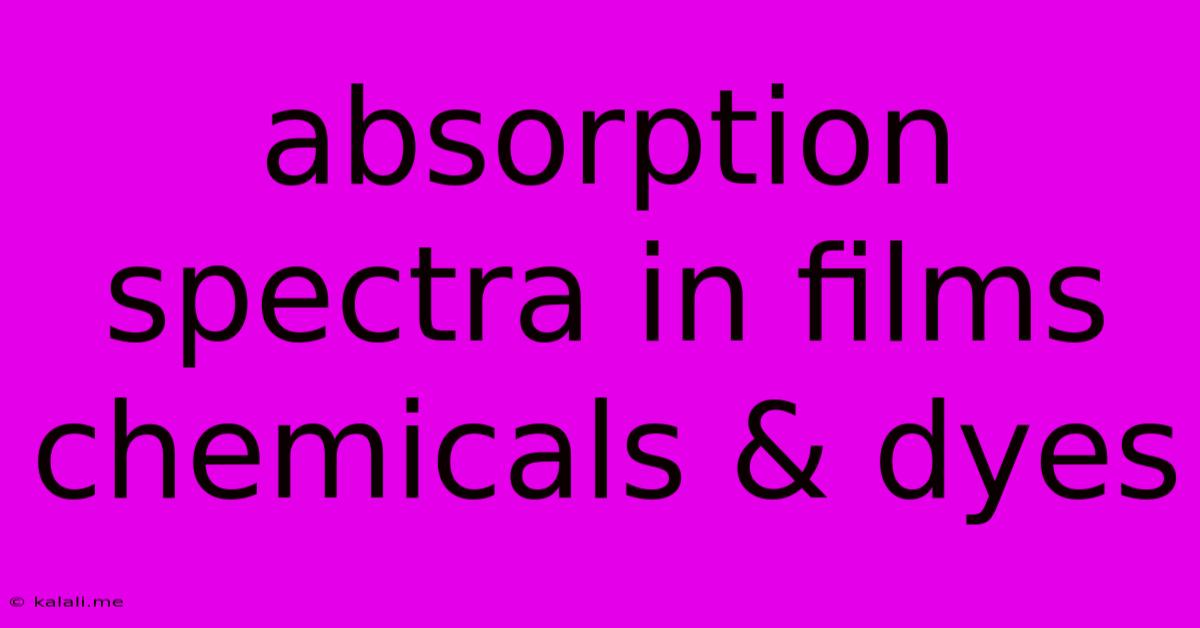Absorption Spectra In Films Chemicals & Dyes
Kalali
Jun 06, 2025 · 4 min read

Table of Contents
Absorption Spectra in Thin Films: Unlocking the Secrets of Chemicals and Dyes
Understanding the absorption spectra of chemicals and dyes in thin film form is crucial across numerous scientific and technological fields. From developing advanced optical devices to analyzing the composition of unknown materials, the ability to interpret these spectra offers invaluable insights. This article delves into the fundamental principles of absorption spectroscopy in thin films, exploring its applications and the factors influencing spectral characteristics.
What is an Absorption Spectrum?
An absorption spectrum is a graph that plots the absorbance (or optical density) of a material against the wavelength of light. Essentially, it shows how much light of different wavelengths a material absorbs. When light interacts with a substance, electrons within the molecules can absorb specific wavelengths of light, causing transitions to higher energy levels. The wavelengths absorbed are characteristic of the material's chemical structure and composition. In thin films, the interaction of light is particularly sensitive to the film's thickness and refractive index.
Thin Film Considerations:
Analyzing absorption spectra in thin films presents unique challenges and opportunities compared to bulk materials. Key factors to consider include:
-
Film Thickness: The absorbance is directly proportional to the concentration of the absorbing species and the path length of the light through the material. In thin films, precise control of thickness is critical for accurate spectral analysis. Even minor variations in thickness can significantly affect the absorbance readings, leading to inconsistencies.
-
Refractive Index: The refractive index of the film influences the interaction of light with the material. This factor affects both the amount of light absorbed and the apparent wavelength of absorption peaks.
-
Substrate Effects: The substrate on which the thin film is deposited can also impact the absorption spectrum. The substrate's absorbance properties can interfere with the film's spectrum, especially if the substrate itself absorbs in the region of interest.
-
Interference Effects: Thin films can exhibit interference effects, especially at specific wavelengths. Constructive and destructive interference can lead to variations in absorbance that aren't solely due to the material's inherent absorption properties. This is particularly important in films with thicknesses comparable to the wavelength of light being used.
-
Scattering: Light scattering within the film can reduce the intensity of the transmitted light, leading to apparent absorbance increases. This can complicate the analysis and requires careful consideration of sample preparation and measurement techniques.
Applications of Absorption Spectra in Thin Films:
The analysis of absorption spectra in thin films has broad applications in diverse fields, including:
-
Chemical Analysis: Identifying unknown chemicals or determining the concentration of known substances within a thin film. This is particularly valuable in fields like material science and analytical chemistry.
-
Dye Characterization: Assessing the absorption properties of dyes used in various applications, such as textiles, solar cells, and optical filters. Understanding the absorption spectrum allows for optimization of dye performance and selection for specific applications.
-
Optical Device Development: Designing and characterizing optical filters, sensors, and other devices that rely on specific wavelength absorption properties. This includes applications in telecommunications, biomedical imaging, and optoelectronics.
-
Semiconductor Characterization: Investigating the electronic band structure and properties of semiconductors. Absorption spectroscopy provides insights into the energy gap and carrier dynamics within semiconductor materials.
Techniques for Measuring Absorption Spectra:
Several techniques are employed to measure the absorption spectra of thin films, including:
-
UV-Vis Spectroscopy: A common and versatile technique used across various wavelengths, from the ultraviolet to the visible regions.
-
Near-Infrared (NIR) Spectroscopy: Used to analyze the absorption properties in the near-infrared region, which is often relevant for studying molecular vibrations and overtones.
-
Ellipsometry: A powerful technique that measures the change in polarization of light reflected from the thin film, enabling the determination of both the absorption and refractive index of the material.
Conclusion:
The absorption spectra of chemicals and dyes in thin films provide a wealth of information about the material's composition, structure, and optical properties. Understanding the influence of factors like film thickness, refractive index, and substrate effects is crucial for accurate interpretation of the spectral data. The widespread applications of this analysis underscore its importance in various scientific and technological domains, from fundamental research to the development of cutting-edge technologies. Further advancements in measurement techniques and data analysis will continue to broaden the scope and impact of this essential analytical tool.
Latest Posts
Latest Posts
-
Urine Stains Smells Around Toilet Base
Jun 06, 2025
-
Satellite Rhel 8 10 Update Breaks Services
Jun 06, 2025
-
Fallout 4 Do Bobbleheads Increase Special Past 10
Jun 06, 2025
-
What Is It Called When A Plant Starts To Die
Jun 06, 2025
-
Can Hoe Can Be Sweep On Minecraft Java
Jun 06, 2025
Related Post
Thank you for visiting our website which covers about Absorption Spectra In Films Chemicals & Dyes . We hope the information provided has been useful to you. Feel free to contact us if you have any questions or need further assistance. See you next time and don't miss to bookmark.